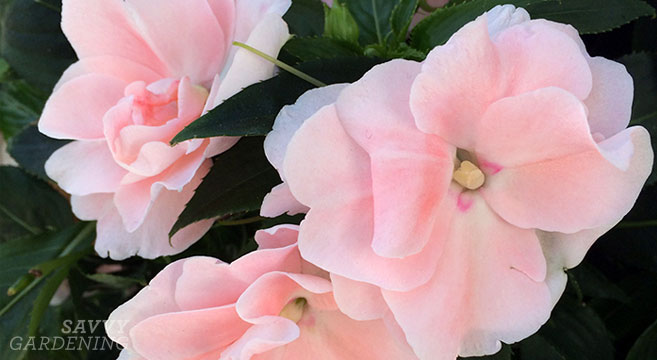This post may contain affiliate links. If you make a purchase through links on our site, we may earn a commission.
I have a pretty sunny property, but there are a few little pockets that don’t see as much sun, if any. In these spots, I’ll pop in some annual flowers for shade to add little sprays of colour—a thin strip on the north side of my house; under a loose hedge of unmanicured cedars in the side yard; in my backyard near the ravine where the tree canopy is thick.
Shade annuals can brighten up a dark corner of a garden and complement the shade perennials that are already there, especially if the garden is all foliage.
When you head to the garden centre, look for the plants that are displayed under some type of awning that shields them from full sun. Those are your shade choices. Read the plant tags carefully to make sure your garden’s conditions will allow the items you choose to flourish throughout the season.
Part-shade annuals vs full-shade annuals
When you read the plant tag, you’ll likely see part shade or full shade written somewhere—or a diagram illustrating one of these options. Be sure that your new annual will be happy with the light conditions you intend to provide. Some might need part sun conditions as part of their day.
Part shade areas generally get about four to six hours of sunlight a day as the sun moves around the garden. Shade may be created by a dappled effect from structures or trees.
Full shade areas really only see indirect light. This might be caused by a heavy tree canopy or when the garden is on the north side of a building.
To determine what kind of shade you have, measure your garden’s conditions (I give a tip about how to do this here). Map how the sun moves throughout the day and where it hits your garden.
Be sure to allow lots of air flow around plants—don’t pack them too tightly together. Overcrowding can lead to mould issues.
Annual flowers for shade
Here is a list of some of my favourite annual flowers for shade.
New Guinea impatiens (Impatiens hawkeri)
**Part shade to full shade
For some reason, that aforementioned strip of garden always gets a neat line of New Guinea impatiens. They’re my go-to every year. I change up the colours, the most recent combo being deep fuchsia flowers, interplanted with white alyssum. New Guinea impatiens prefer part shade. I’ve found that the sun will burn or bleach the petals if they are in too much direct sunlight for too many hours. They are a nice alternative to impatiens walleriana, which are affected by downy mildew. I find they have a nice mounding habit that spreads throughout the season.



Browallia
**Part shade to full shade
I discovered this shade annual a few years ago and loved the way the white centres of the purplish-blue flowers glowed under my cedars. The plants are also referred to as amethyst or sapphire flowers because of their shape. Browallia is heat tolerant and will bloom throughout the summer, no deadheading required.

Fuchsia
**Part shade to full shade (check the plant tag when purchasing)
Did you know the common name for fuchsia is lady’s eardrops? I didn’t, until recently. I suppose the flowers do look like elaborate drop earrings. You’ll often see these plants in hanging baskets as the flowers like to cascade over the side. I’ve also seen them climbing inside conservatories. They are also planted as bushes, but you can get a much better view of these gorgeous blooms from a higher vantage point. Fuchsias bloom from the spring through to the first frost. It’s hard to keep them as houseplants, so it’s recommended they be brought inside and cut back to go dormant for the winter. You’ll want to deadhead old flowers to promote new growth throughout the season (though some varieties don’t require this), as well as fertilize plants regularly. Be careful not to overwater.

Sweet Alyssum (Lobularia maritima)
**Part shade to full sun
Alyssum is one of those versatile plants you can tuck into various parts of the garden. I’ve had success planting it in full sun and part shade. I plant it in my raised beds to attract parasitic wasps, I plant it in my ornamental gardens, and I’ve tucked it into containers to fill spaces (it’s a good spiller). Pollinators love it, too!

Begonias
**Part shade to full shade
Begonias are reliable shade annuals that come in a variety of both leaf and flower colours, and shapes for that matter. When I’m done making container arrangements, I usually pick up a couple of hanging baskets meant for shady spots, and pop them in my terracotta pots. You’ll likely see wax, tuberous, and angel wing on plant tags. Plant them in light, well-drained soil after all threat of frost has passed. Begonias need good drainage, so if you do plant them in a pot, make sure there is a hole in the bottom to avoid root rot. For this same reason, if they’re planted in the ground, you may want to keep them away from wood mulch.


Viola
**Part shade
Considered a hardy annual, violas are more of a cool-season plant that don’t mind full-sun exposure in the spring and fall, but I’ve stretched their growing season by moving them to cooler, shadier spots for the summer. They are quite easy to start from seed, and fun to add to a spring garden, especially in spring pots.

What are your favourite shade annuals?
Pin it!




Leave a Reply